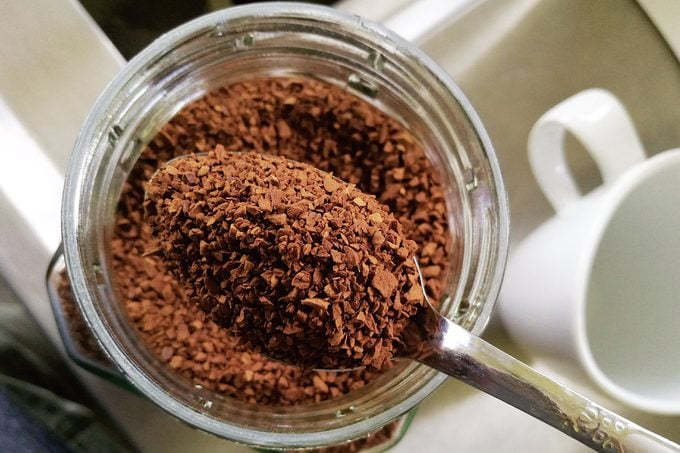Is Instant Coffee Bad or Good for You?
Updated: Jul. 12, 2021
Here's what to know about instant coffee vs. ground coffee including how much caffeine is in instant coffee and what it is exactly.
Our editors and experts handpick every product we feature. We may earn a commission from your purchases.
Instant coffee 101
If the best part of your day is your hot cup of coffee first thing in the morning, then waiting forever for it to brew is likely one of the worst—or at least longest—parts of your day.
That’s why some people turn to a convenient and quick cup of instant coffee instead.
But is opting for instant coffee powder out of convenience doing more harm than good?
“Instant coffee is a convenient way to make a quick cup of coffee on busy mornings, during travel, or when on the go,” says Malina Malkani, RDN, a registered dietitian nutritionist and author.
In moderation, it can absolutely fit into a healthy diet and contains many health-promoting agents, she says.
We spoke with nutrition experts and took a look at the research on everything you need to know about instant coffee and its health effects.
Here’s the lowdown on instant coffee, including what it is, if it’s good for you, and how it compares to the regular ground stuff.

What is instant coffee?
Instant coffee is simply the crystals that form after dehydrating brewed coffee, explains Malkani.
The process involves brewing ground coffee beans, just like regular coffee. Then the water is removed from the extract to create a concentrated dry powder or crystals.
“The dehydrated crystals can then be reconstituted with boiling water to produce a cup of instant coffee,” Malkani says.
Stores sell instant coffee in granules or as single-serving sticks or sachets. If you opt for the granules, add one teaspoon of powder to a cup of hot water and voila, you’ve got instant coffee.
Megan Meyer, the director of science communication at the International Food Information Council Foundation, notes that instant coffee powder has a longer shelf life than coffee beans and is cheaper.
How to make instant coffee
There are two ways to make instant coffee: spray-drying or freeze-drying.
The spray drying method is spraying coffee extract into hot hair so it dries the droplets into a powder.
Freeze-drying starts with small, cut up pieces of frozen extract. They are then dried at a low temperature.
(Here’s why French press coffee is bad for you.)
Instant coffee vs. ground coffee
Caffeine
Instant and regular brewed coffee have nearly identical nutrition profiles, according Meyer.
“The differences are so small that it’s likely negligible in terms of health for all with the exception of caffeine content,” Malkani says.
The main distinction is in their caffeine content: An eight-ounce cup of instant coffee has about 62 milligrams of caffeine, while an eight-ounce cup of brewed coffee has 96 milligrams, per Meyer.
Ground coffee contains more caffeine than instant because of the increased processing necessary to make instant coffee, during which more caffeine is lost, according to Malkani.
“For some, the difference may be significant when you consider that the Food and Drug Administration (FDA) states that a maximum of 400 mg of caffeine per day appears to be safe for most healthy adults,” Malkani says.
It’s safe for most people to consume up to 400 milligrams of caffeine per day, according to Meyer. That’s about four cups of brewed coffee or 6 cups of instant coffee.
Remember, too much caffeine could lead to restlessness, anxiety, stomach aches, and more. So it’s wise to control your caffeine consumption.
If you’re sensitive to caffeine or have anxiety or a heart condition, you might want to switch to decaf regular or instant coffee.
Acrylamide
Instant coffee contains marginally more acrylamide, according to Malkani. This potentially harmful chemical forms in some foods during high-temperature cooking processes, such as frying, roasting, and baking, per the FDA. So it may form after roasting coffee beans.
Research in the Annals of the National Institute of Hygiene looked at acrylamide levels in 42 commercial samples of roasted and instant coffee, and in coffee substitutes.
They found the highest mean acrylamide concentrations in coffee substitutes, followed by instant coffee, and then roasted coffee. But roasted coffee had about half as much acrylamide as instant, per the report.
One study in Nutritional Neuroscience found that acrylamide accumulation in your system causing neuropathy or nerve damage. And the American Cancer Society also notes that acrylamide overexposure is linked to an increased risk of cancer.
Still, the European Food Safety Authority panel and Malkani support that the amount of acrylamide people get from their diets (or in their coffee) is not enough to pose serious health concerns.
Taste
Another way instant coffee can differ from brewed coffee is taste. Since taste is highly subjective—what you like isn’t necessarily what I like—you’ll probably have to try instant coffee to see if it works for you.
That said, instant coffee generally gets lower marks for taste, and is often said to be more bitter and lack flavor compared with brewed coffee.
Of course, the quality of the beans used to make instant coffee can make a difference. Some brands have focused on improving the taste of instant coffee, including Waka and Swift Cup.
Other things to remember about coffee and nutrition
“What has a greater impact on whether coffee promotes or detracts from overall health is what we add into it,” Malkani says.
That includes sweeteners, creams, and milk. Plus, both dairy and plant-based creamers add unnecessary calories. And so do sweeteners and sugar.
Opting for zero-calorie sweeteners like monk fruit or stevia are alternatives to consider.
Next, check out some other ways to make your coffee habit healthier.




















